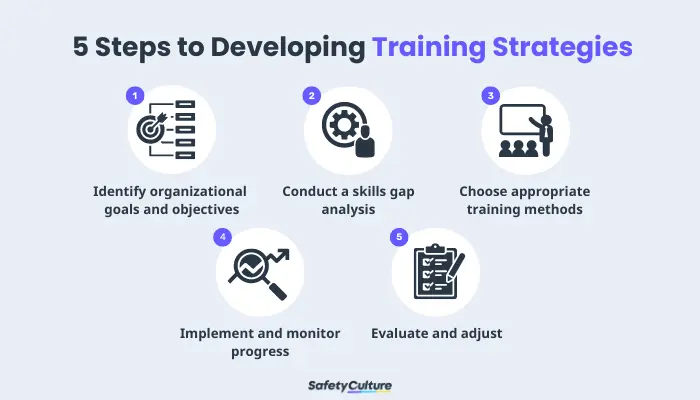What is a Training Strategy?
A training strategy is a carefully planned approach to developing and enhancing the knowledge, skills, and abilities of employees in an organization. It’s a great way to plan and outline the goals, methods, and resources needed to deliver effective workplace training programs.
The primary purpose of a training strategy is to align the organization’s training initiatives with its overall objectives and priorities. It involves identifying the specific needs and skill gaps among employees, designing appropriate training programs, and implementing them in a structured and coordinated manner.
Importance and Benefits
A well-designed training strategy is important to both your organization and employees. Here’s why:
- Strategic Alignment – When you craft a strategic training plan, you ensure that your learning and development initiatives perfectly line up with your organization’s overall goals and objectives.
- Increased Employee Performance – By addressing skill gaps and promoting continuous learning, you can empower your workforce to excel in their roles.
- Employee Engagement and Satisfaction – Effective training methods foster a culture of learning and development within your organization, which can significantly impact employee engagement and satisfaction. In particular, offering training and development opportunities shows that you value and support your employees’ growth and professional development.
- Adaptation to Industry Changes – A good training process helps employees stay current with industry trends and developments, as well as develop the skills they need to adapt to changes – whether it’s new processes, technology, or market trends. This helps position the organization as an agile and forward-thinking player.
Types of Employee Training Strategies
Here are some common types of employee training strategies that you can apply to meet your organization’s specific needs and goals:
On-the-Job Training
On-the-job training involves learning and developing new skills while actively performing real job tasks. It’s a hands-on approach that allows employees to acquire skills in the context of their daily responsibilities.
Ideal for: Roles where practical skills and real-time problem-solving are crucial, such as manufacturing, customer service, or technical support.
Workshops and Seminars
This training approach brings employees together in a focused learning environment. They often involve expert facilitators, group activities, and discussions.
Ideal for: Conveying theoretical knowledge, facilitating collaboration, and encouraging the exchange of ideas.
E-Learning and Online Courses
E-learning uses digital platforms to deliver flexible and accessible training content. This includes online courses, webinars, and interactive modules. Digital learning solutions like Training from the SafetyCulture platform can be accessible on any device, enabling them to access bite-sized training on the go.
Ideal for: Organizations with remote or dispersed teams and for skills that can be effectively taught through digital mediums.
Mentorship Programs
This type of training pairs experienced employees (mentors) with newcomers or less experienced counterparts (mentees). This one-on-one relationship helps facilitate knowledge transfer and skill development.
Ideal for: Roles that benefit from personalized guidance and practical insights.
How to Develop Training Strategies for the Workplace
Developing effective training strategies involves a step-by-step process that takes into account organizational goals and the specific needs of employees. These are the five steps you can take to make it work.

5 Steps to Developing Training Strategies
Step 1. Identify Organizational Goals and Objectives
Before designing a training strategy, organizations must lay a solid foundation by clearly defining their goals and objectives.
Organizational goals are the broad, overarching achievements that the company aims to reach over a specific period. These could include revenue targets, market share expansion, product launches, or improvements in customer satisfaction.
Objectives, on the other hand, are the specific and measurable targets that contribute to reaching the broader organizational goals once achieved. For instance, if the goal is to increase market share, an objective could be achieving a 15% increase in market share within the next fiscal year.
You can identify organizational goals and objectives for training initiatives through these actions:
- Engage key stakeholders, including executives, department heads, and team leaders, in discussions to gain a holistic view of the company’s direction.
- Review existing strategic documents, such as business plans, annual reports, or vision statements. These documents often articulate the high-level goals and objectives of the organization.
- Ensure that the goals set for training programs directly align with the identified organizational objectives.
Step 2. Conduct a Skills Gap Analysis
After identifying the organizational goals and objectives, the next step is to conduct a skills gap analysis. It will serve as a diagnostic tool that provides insights into the current skill set of the workforce compared to the skills required to achieve organizational objectives.
Determine the gaps by following these steps:
- List the skills and competencies required for each role within the organization. Consult job descriptions, industry benchmarks, and feedback from team leaders to compile a comprehensive list.
- Use surveys, performance reviews, and feedback sessions to evaluate the existing skill set of employees, including their strengths, weaknesses, and areas for improvement.
- Systematically compare the identified skills and competencies with the requirements of each role.
- Prioritize the identified gaps based on their significance to individual roles and alignment with organizational goals. After all, not all skills are equally critical for every role.
- Develop a personalized development plan for each employee that outlines the specific training interventions required to bridge the identified skills gap.
Step 3. Choose Appropriate Training Methods
Once you’ve identified the skills gap through a thorough analysis, the next step is to choose the right and effective training techniques. This step involves carefully assessing the best ways for employees to learn and develop the needed skills while taking into account their preferences.
Each approach has its strengths, so you need to choose the methods that suit the exact skills you want to cultivate with your employees.
When selecting training styles, it’s essential to consider these factors:
- The nature of the skills targeted for development (on-the-job training, interactive workshops, online learning modules, mentorship programs)
- Learning preferences of the workforce
- Available budget and resources for training
Step 4. Implement and Monitor Progress
Implementation and progress monitoring is the stage where all your well-crafted plans come to life, and you start seeing the real impact of the training in action. It’s vital as they allow for adjustments and provide measurable results, giving you a clear return on investment (ROI).
Here’s a breakdown of the steps involved in implementing and monitoring progress:
- Communicate all important details to participants before the training begins. Discuss the schedules, expectations, and benefits of the training.
- Conduct learning sessions according to the chosen methods and ensure that the facilitators are well-prepared and that participants actively engage with the content.
- Take advantage of technology to track participation, completion rates, and assessment scores. Employee training software, such as learning management systems (LMS), can provide insights into their progress and overall success.
- Collect feedback from participants through surveys, interviews, or focus group discussions. Analyze and use it to make data-driven decisions for improvements.
Step 5. Evaluate and Adjust
Post-implementation, it’s necessary to conduct a thorough training evaluation. This phase is an essential part of an ongoing cycle of improvement that helps ensure your training initiatives remain effective and aligned with your organization’s evolving needs.
You can perform a training evaluation and adjustment through these actions:
- Evaluate how well participants have acquired and applied the targeted skills and knowledge. Measure the extent to which they have successfully developed the desired competencies.
- Look back at the KPIs established at the beginning of your training strategy and assess whether the training has had a positive impact on these indicators.
- Directly engage with the participants to gather their feedback on the content, training delivery methods, and practical applicability.
- Involve department heads, team leaders, and executives in the evaluation process to have a broader view of the training’s impact on team dynamics and overall organizational performance.
Depending on the results of the evaluation, you can identify areas for improvement, update training materials, and modify future training strategies.
FAQs about Training Strategies
Implementing training strategies is a team effort. Human Resources (HR) takes charge of overall coordination to ensure that the training initiatives are well-suited to the company’s goals. Dedicated training and development teams play a vital role in designing and delivering effective training programs tailored to meet specific skill needs. Departmental managers also play a part in making sure that the training aligns with the requirements of their respective teams.
There’s no one-size-fits-all solution when it comes to employee training. The effectiveness of training relies on several factors, such as goals, skills, and the workforce.
Although interactive and hands-on methods can highly engage participants, it’s ultimately up to how you customize the training to your organization’s needs, consider diverse learning styles, and include feedback. You’ll have to find the right approach that works best for your organization.
The frequency of these reviews can vary, but it’s generally recommended to do them annually or more often if there are significant shifts in industry trends, technology, or organizational priorities.



